jmglov's blog
A blog about stuff but also things.
A blog about stuff but also things.

Last time on "Soundcljoud, or a young man's Soundcloud clonejure", I promised to clone Soundcloud, but then got bogged down in telling the story of my life and never got around to the actual cloning part. 😬
To be fair to myself, I did do a bunch of stuff to prepare for cloning, so now we can get to it with no further ado! (Skipping the ado bit is very out of character for me, I know. I'll just claim this parenthetical as my ado and thus fulfil your expectations of me as the most verbose writer in the Clojure community. You're welcome!)
If you've followed along with any of my other cloning adventures, you'll know where I'm going with this: straight to Scittle Town!
I'll start by creating a player directory and dropping a bb.edn into it:
{:deps {io.github.babashka/sci.nrepl
{:git/sha "2f8a9ed2d39a1b09d2b4d34d95494b56468f4a23"}
io.github.babashka/http-server
{:git/sha "b38c1f16ad2c618adae2c3b102a5520c261a7dd3"}}
:tasks {http-server {:doc "Starts http server for serving static files"
:requires ([babashka.http-server :as http])
:task (do (http/serve {:port 1341 :dir "public"})
(println "Serving static assets at http://localhost:1341"))}
browser-nrepl {:doc "Start browser nREPL"
:requires ([sci.nrepl.browser-server :as bp])
:task (bp/start! {})}
-dev {:depends [http-server browser-nrepl]}
dev {:task (do (run '-dev {:parallel true})
(deref (promise)))}}}
In short, what's happening here is I'm setting up a Babashka project with a dev task that starts a webserver on port 1341 serving up the files in the public/ directory, starts an nREPL server on port 1339 that we can connect to with Emacs (or any inferior text editor of your choosing), and a websocket server on port 1340 that is connected to the nREPL server on one end and waiting for a ClojureScript app to connect to the other end.
Speaking of the public/ directory, I need a public/index.html file to serve up:
<!doctype html>
<html class="no-js" lang="">
<head>
<meta charset="utf-8">
<meta http-equiv="x-ua-compatible" content="ie=edge">
<title>Soundcljoud</title>
<meta name="description" content="">
<meta name="viewport" content="width=device-width, initial-scale=1">
<link rel="stylesheet" href="style.css">
<script src="https://cdn.jsdelivr.net/npm/scittle@0.6.15/dist/scittle.js" type="application/javascript"></script>
<script src="https://cdn.jsdelivr.net/npm/scittle@0.6.15/dist/scittle.promesa.js" type="application/javascript"></script>
<script>var SCITTLE_NREPL_WEBSOCKET_PORT = 1340;</script>
<script src="https://cdn.jsdelivr.net/npm/scittle@0.6.15/dist/scittle.nrepl.js"
type="application/javascript"></script>
<script type="application/x-scittle" src="soundcljoud.cljs"></script>
</head>
<body>
<h1>Soundcljoud</h1>
<div id="wrapper" style="display: none;">
<div id="player">
<div class="cover-image">
<img src="" alt="" />
</div>
<div id="controls">
<audio controls src=""></audio>
<div id="tracks" style=""></div>
</div>
</div>
</div>
</body>
</html>
The index.html file loads three JavaScript scripts:
Once this JavaScript is in place, index.html loads the soundcljoud.cljs ClojureScript file, which we'll come to in just a second.
For a (much) more detailed explanation, refer to the Popping in a Scittle section of my cljcastr, or a young man's Zencastr clonejure blog post.
The body of index.html is all about setting up a basic HTML page with this structure:
+----------------------+
| Soundcljoud |
+-------+--------------+ <---
| Album | Audio player | }
| cover +--------------+ } <div id="wrapper">
| image | Tracks list | }
+-------+--------------+ <---
Note that everything inside the wrapper div is hidden from the start:
<div id="wrapper" style="display: none;">
We don't know anything about the album we want to display yet, and there's no point in showing a bunch of empty divs until we do.
Let's drop a public/style.css in as well:
body {
font:
1.2em Helvetica,
Arial,
sans-serif;
margin: 20px;
padding: 0;
}
img {
max-width: 100%;
}
#wrapper {
max-width: 960px;
margin: 2em auto;
}
#controls {
display: flex;
flex-direction: column;
gap: 5px;
}
#tracks {
display: flex;
flex-direction: column;
gap: 3px;
}
@media screen and (min-width: 900px) {
#wrapper {
display: flex;
}
#player {
display: flex;
gap: 3%;
}
#cover-image {
margin-right: 5%;
max-width: 60%;
}
#controls {
width: 25%;
}
}
All of this stuff is about using screen real estate effectively. The first chunk of CSS applies universally, but the bit inside this:
@media screen and (min-width: 900px) {
/* ... */
}
only applies to windows at least 900px wide. So our page defaults to a layout that's appropriate for phones (or really narrow browser windows), but then adjusts to move more content "above the fold" so you can probably see the entire UI without scrolling if you're viewing the page on a standard computer.
Now that we have all of the HTML and CSS plumbing in place, let's add a public/soundcljoud.cljs file to get started with some ClojureScripting:
(ns soundcljoud
(:require [promesa.core :as p]))
Before we can start REPL-driving, we need to put the key in the ignition and give it a right twist! In other words, we open up a terminal in the top-level player/ directory and invoke Babashka:
: jmglov@alhana; bb dev
Serving static assets at http://localhost:1341
nREPL server started on port 1339...
Websocket server started on 1340...
If we now connect to http://localhost:1341/, we'll be rewarded with a simple webpage:
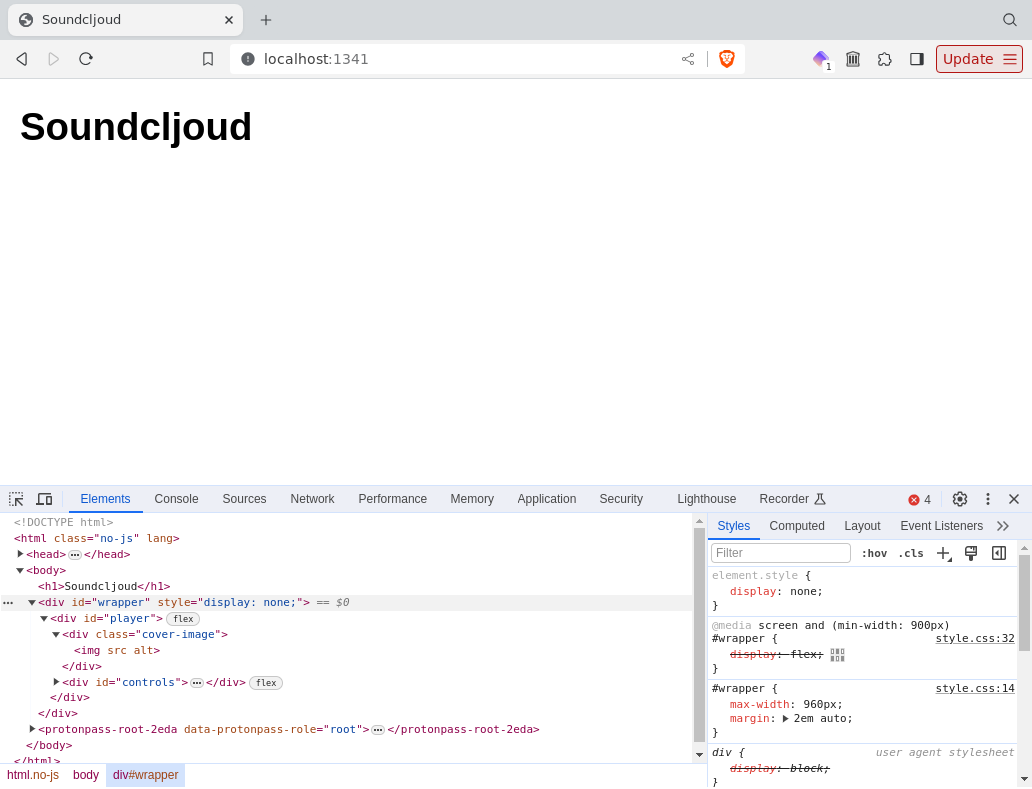
This by itself is of course monumentally boring, so let's inject some excitement into our lives by jumping into soundcljoud.cljs and pressing C-c l C (cider-connect-cljs), selecting localhost, port 1339, and nbb for the REPL type (assuming you're in Emacs; if you're using some other editor, perform the incantations necessary to connect your ClojureScript REPL to localhost:1339).
If everything went according to plan, you should see something like this in your terminal window:
:msg "{:versions
{\"scittle-nrepl\"
{\"major\" \"0\", \"minor\" \"0\", \"incremental\" \"1\"}},
:ops
{\"complete\" {}, \"info\" {}, \"lookup\" {}, \"eval\" {},
\"load-file\" {}, \"describe\" {}, \"close\" {}, \"clone\" {},
\"eldoc\" {}},
:status [\"done\"],
:id \"3\",
:session \"3264dc1e-1b46-48a6-b11a-f606fea032b7\",
:ns \"soundcljoud\"}"
:msg "{:value \"nil\",
:id \"5\",
:session \"3264dc1e-1b46-48a6-b11a-f606fea032b7\",
:ns \"soundcljoud\"}"
:msg "{:status [\"done\"],
:id \"5\",
:session \"3264dc1e-1b46-48a6-b11a-f606fea032b7\",
:ns \"soundcljoud\"}"
And something like this in your editor's REPL window:
;; Connected to nREPL server - nrepl://localhost:1339
;; CIDER 1.12.0 (Split)
;;
;; ClojureScript REPL type: nbb
;;
nil>
Let's prove that it works by evaluating the buffer with C-c C-k (cider-load-buffer), adding a Rich
comment, putting some ClojureScript in there that grabs our wrapper div, positioning our cursor at the end of the form, and evaluating that sucker with C-c C-v f c e (cider-pprint-eval-last-sexp-to-comment):
(ns soundcljoud
(:require [promesa.core :as p]))
(comment
(js/document.querySelector "#wrapper")
;; => #object[HTMLDivElement [object HTMLDivElement]]
)
We've proven that we can evaluate ClojureScript code in the running browser process from our REPL buffer, which is nifty for sure, but our page still bores us, and the result of evaluating that code is pretty useless:
#object[HTMLDivElement [object HTMLDivElement]]
Let's actually do something with the div we've pulled down, and whilst we're at it, provide a useful way of logging stuff:
(ns soundcljoud
(:require [promesa.core :as p]))
(defn log
([msg]
(log msg nil))
([msg obj]
(if obj
(js/console.log msg obj)
(js/console.log msg))
obj))
(comment
(let [div (js/document.querySelector "#wrapper")]
(set! (.-style div) "display: flex")
(log "All is revealed!" div))
;; => #object[HTMLDivElement [object HTMLDivElement]]
)
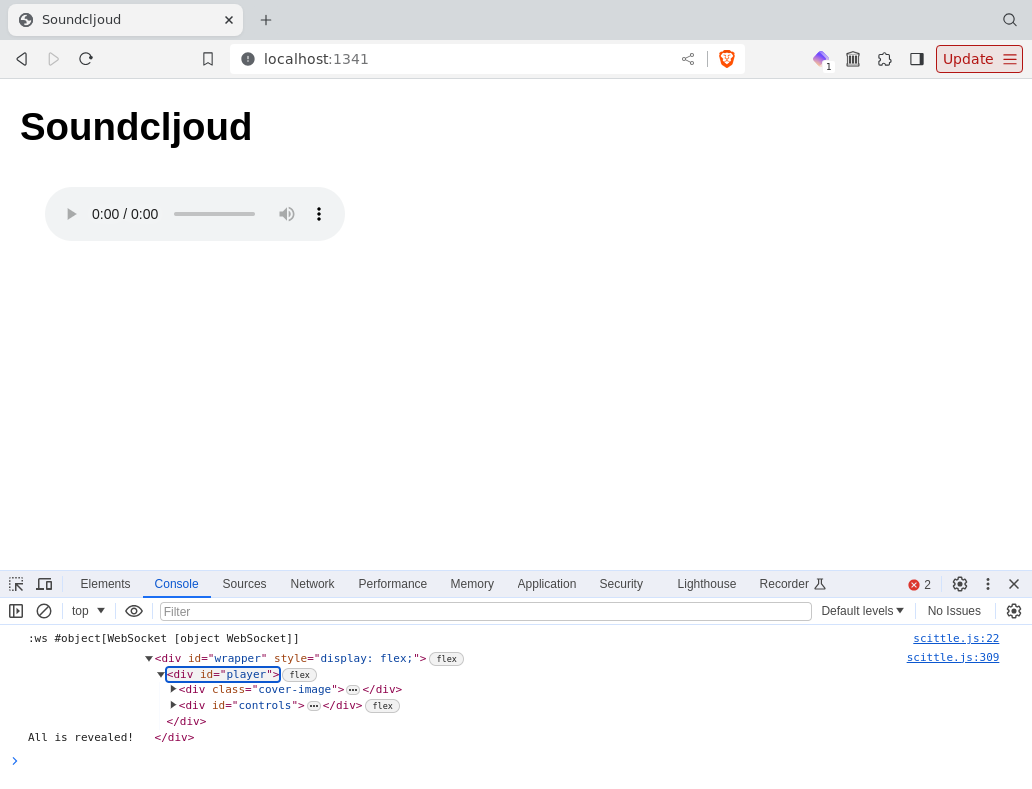
Fantastic! By using js/document.log (by the way, that js/ prefix is the way you instruct ClojureScript to do some JavaScript interop; it's basically saying "look for the next symbol in the top-level scope in JavaScript land"), we now get the fancy inspection tools in the browser's JavaScript console so we can expand parts of the object and drill down to see stuff we're interested in.
Now that we've established a baseline, we can get stuck in and do some real work. 💪🏻
Do you remember the MP3 files and RSS
feed we prepared in the previous blog post? Let's plop those down in our public/ directory so we can access them from the webapp we're slowly constructing:
: jmglov@alhana; mkdir -p 'public/Garth Brooks/Fresh Horses'
: jmglov@alhana; cp /tmp/soundcljoud.12524185230907219576/*.{rss,mp3} !$
: jmglov@alhana; ls -1 !$
album.rss
'Garth Brooks - Cowboys and Angels.mp3'
'Garth Brooks - Ireland.mp3'
"Garth Brooks - It's Midnight Cinderella.mp3"
"Garth Brooks - Rollin'.mp3"
"Garth Brooks - She's Every Woman.mp3"
"Garth Brooks - That Ol' Wind.mp3"
'Garth Brooks - The Beaches of Cheyenne.mp3'
'Garth Brooks - The Change.mp3'
'Garth Brooks - The Fever.mp3'
'Garth Brooks - The Old Stuff.mp3'
Now that our files are in place, let's see about loading the RSS feed from ClojureScript:
(comment
(def base-path "/Garth+Brooks/Fresh+Horses")
;; => #'soundcljoud/base-path
(p/->> (js/fetch (js/Request. (str base-path "/album.rss")))
(.text)
(log "Fetched XML:"))
;; => #<Promise[~]>
)
In our console, we can see what we fetched:
Fetched XML: <?xml version='1.0' encoding='UTF-8'?>
<rss version="2.0"
xmlns:itunes="http://www.itunes.com/dtds/podcast-1.0.dtd"
xmlns:atom="http://www.w3.org/2005/Atom">
<channel>
<atom:link
href="http://localhost:1341/Garth+Brooks/Fresh+Horses/album.rss"
rel="self"
type="application/rss+xml"/>
<title>Garth Brooks - Fresh Horses</title>
<link>https://api.discogs.com/masters/212114</link>
<pubDate>Sun, 01 Jan 1995 00:00:00 +0000</pubDate>
<itunes:subtitle>Album: Garth Brooks - Fresh Horses</itunes:subtitle>
<itunes:author>Garth Brooks</itunes:author>
<itunes:image href="https://i.discogs.com/0eLXmM1tK1grkH8cstgDT6eV2TlL0NvgWPZBoyScJ_8/rs:fit/g:sm/q:90/h:600/w:600/czM6Ly9kaXNjb2dz/LWRhdGFiYXNlLWlt/YWdlcy9SLTY4NDcx/Ny0xNzE3NDU5MDIy/LTMxNjguanBlZw.jpeg"/>
<item>
<itunes:title>The Old Stuff</itunes:title>
<title>The Old Stuff</title>
<itunes:author>Garth Brooks</itunes:author>
<enclosure
url="http://localhost:1341/Garth+Brooks/Fresh+Horses/Garth+Brooks+-+The+Old+Stuff.mp3"
length="5943424" type="audio/mpeg" />
<pubDate>Sun, 01 Jan 1995 00:00:00 +0000</pubDate>
<itunes:duration>252</itunes:duration>
<itunes:episode>1</itunes:episode>
<itunes:episodeType>full</itunes:episodeType>
<itunes:explicit>false</itunes:explicit>
</item>
...
<item>
<itunes:title>Ireland</itunes:title>
<title>Ireland</title>
<itunes:author>Garth Brooks</itunes:author>
<enclosure
url="http://localhost:1341/Garth+Brooks/Fresh+Horses/Garth+Brooks+-+Ireland.mp3"
length="6969472" type="audio/mpeg" />
<pubDate>Sun, 01 Jan 1995 00:00:00 +0000</pubDate>
<itunes:duration>301</itunes:duration>
<itunes:episode>10</itunes:episode>
<itunes:episodeType>full</itunes:episodeType>
<itunes:explicit>false</itunes:explicit>
</item>
</channel>
</rss>
That looks quite familiar! That also looks like a bunch of text, which is not the nicest thing to extract data from. Luckily, that's a bunch of structured text, and more luckily, it's XML (XML is great, and don't let anyone tell you otherwise! And don't get me started on how we've reinvented XML but poorly with JSON Schema and all of this other nonsense we've built up around JSON because we realised that things like data validation are important when exchanging data between machines. 🤦🏼♂️), and most luckily of all, browsers know how to parse XML (which makes sense, as modern HTML is in fact XML):
(defn parse-xml [xml-str]
(.parseFromString (js/window.DOMParser.) xml-str "text/xml"))
(comment
(p/->> (js/fetch (js/Request. (str base-path "/album.rss")))
(.text)
parse-xml
(log "Fetched XML:"))
;; => #<Promise[~]>
)
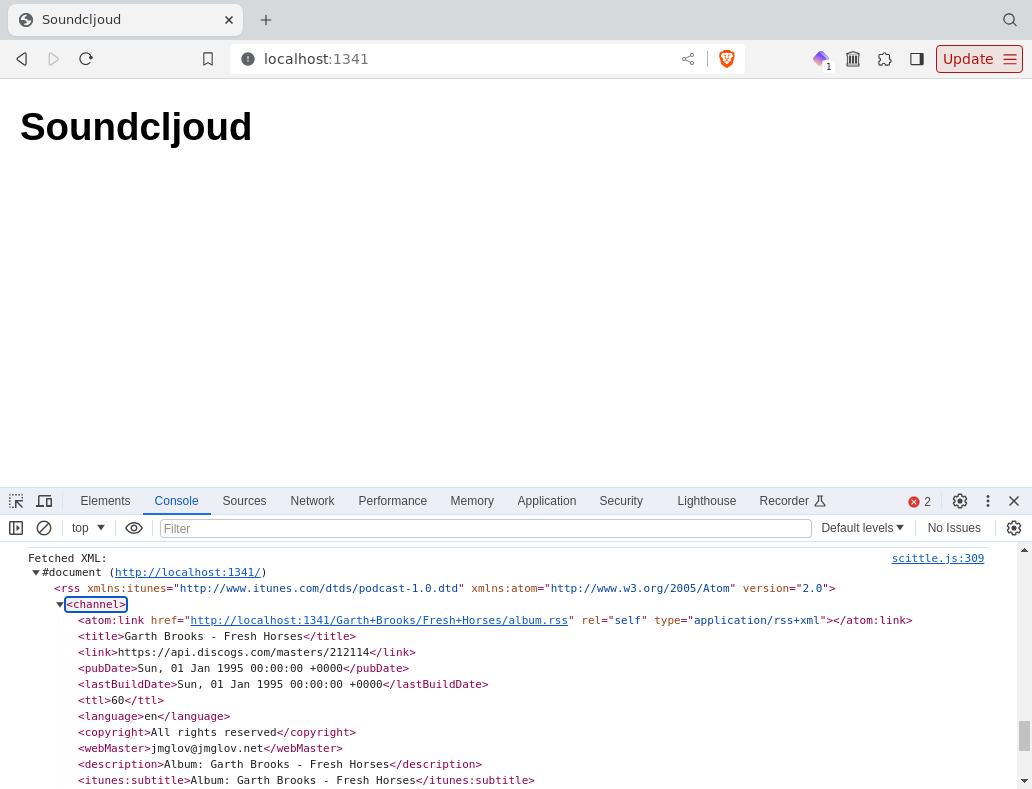
Let's do the right thing and make a function out of this:
(defn fetch-xml [path]
(p/->> (js/fetch (js/Request. path))
(.text)
parse-xml
(log "Fetched XML:")))
Now that we know how to fetch and parse XML, let's see how to extract useful information from it. Looking at the log output, we can see that the parsed XML is of type #document, just like our good friend js/document (the current webpage that the browser is displaying). That's right, we have a Document Object Model, which means we can use all the tasty DOM functions we're used to, such as document.querySelector() to grab a node using an XPATH query.
Let's start with the album title:
(comment
(p/let [title (p/-> (fetch-xml (str base-path "/album.rss"))
(.querySelector "title")
(.-innerHTML))]
(set! (.-innerHTML (js/document.querySelector "h1")) title))
;; => #<Promise[~]>
)
Cool! We now see "Garth Brooks - Fresh Horses" as our page heading! Let's see about grabbing the album art next:
(comment
(p/let [xml (fetch-xml (str base-path "/album.rss"))
title (p/-> xml
(.querySelector "title")
(.-innerHTML))
image (p/-> xml
(.querySelector "image")
(.getAttribute "href"))]
(set! (.-innerHTML (js/document.querySelector "h1")) title)
(set! (.-src (js/document.querySelector ".cover-image > img")) image)
(set! (.-style (js/document.querySelector "#wrapper")) "display: flex;"))
;; => #<Promise[~]>
)
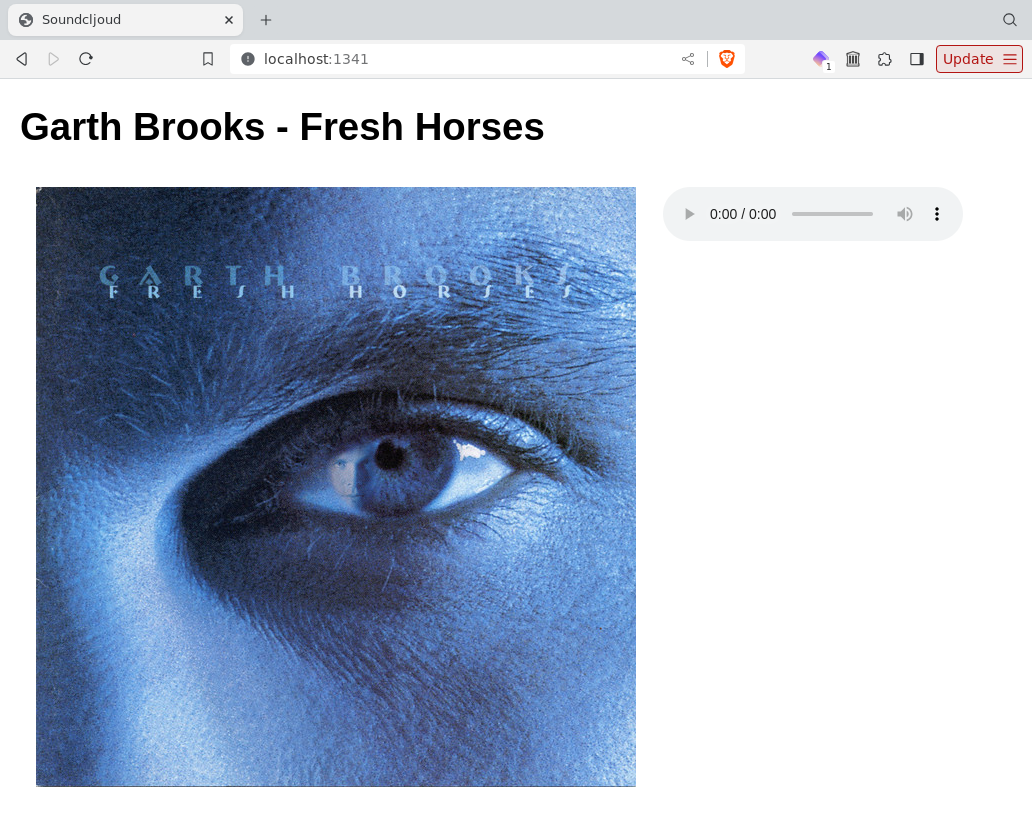
Before we go any further, let's create some functions from this big blob of code. At the moment, we're complecting two things:
Let's do the functional programming thing and create a purely functional core and a mutable shell. Instead of extracting and updating, we'll create a function that transforms the XML DOM representation of an album into a ClojureScript representation:
(defn xml-get [el k]
(-> el
(.querySelector k)
(.-innerHTML)))
(defn xml-get-attr [el k attr]
(-> el
(.querySelector k)
(.getAttribute attr)))
(defn ->album [xml]
{:title (xml-get xml "title")
:image (xml-get-attr xml "image" "href")})
(defn load-album [path]
(p/-> (fetch-xml path) ->album))
(comment
(p/let [{:keys [title image] :as album} (load-album (str base-path "/album.rss"))]
(set! (.-innerHTML (js/document.querySelector "h1")) title)
(set! (.-src (js/document.querySelector ".cover-image > img")) image)
(set! (.-style (js/document.querySelector "#wrapper")) "display: flex;"))
;; => #<Promise[~]>
)
Now that we have a nice ClojureScript data structure to represent our album, let's tackle the DOM mutations we need to do to display the album:
(defn get-el [selector]
(if (instance? js/HTMLElement selector)
selector ; already an element; just return it
(js/document.querySelector selector)))
(defn set-styles! [el styles]
(set! (.-style el) styles))
(defn display-album! [{:keys [title image] :as album}]
(let [header (get-el "h1")
cover (get-el ".cover-image > img")
wrapper (get-el "#wrapper")]
(set! (.-innerHTML header) title)
(set! (.-src cover) image)
(set-styles! wrapper "display: flex;")
album))
(comment
(p/-> (load-album (str base-path "/album.rss")) display-album!)
;; => #<Promise[~]>
)
Displaying the album title and cover art is all well and good, but in order to complete our Soundcloud clone, we need some way of actually listening to the music on the album. If you recall, our RSS feed contains a series of <item> tags representing the tracks:
<item>
<itunes:title>The Old Stuff</itunes:title>
<title>The Old Stuff</title>
<itunes:author>Garth Brooks</itunes:author>
<enclosure
url="http://localhost:1341/Garth+Brooks/Fresh+Horses/Garth+Brooks+-+The+Old+Stuff.mp3"
length="5943424" type="audio/mpeg" />
<pubDate>Sun, 01 Jan 1995 00:00:00 +0000</pubDate>
<itunes:duration>252</itunes:duration>
<itunes:episode>1</itunes:episode>
<itunes:episodeType>full</itunes:episodeType>
<itunes:explicit>false</itunes:explicit>
</item>
...
<item>
<itunes:title>Ireland</itunes:title>
<title>Ireland</title>
<itunes:author>Garth Brooks</itunes:author>
<enclosure
url="http://localhost:1341/Garth+Brooks/Fresh+Horses/Garth+Brooks+-+Ireland.mp3"
length="6969472" type="audio/mpeg" />
<pubDate>Sun, 01 Jan 1995 00:00:00 +0000</pubDate>
<itunes:duration>301</itunes:duration>
<itunes:episode>10</itunes:episode>
<itunes:episodeType>full</itunes:episodeType>
<itunes:explicit>false</itunes:explicit>
</item>
What we need from each item in order to display and play the track is:
Let's write an aspirational function that assumes it will be called with a DOM element representing an <item> and transforms it into a ClojureScript map, just as we did for the item itself:
(defn ->track [item-el]
{:artist (xml-get item-el "author")
:title (xml-get item-el "title")
:number (-> (xml-get item-el "episode") js/parseInt)
:src (xml-get-attr item-el "enclosure" "url")})
For the track number, we need to convert it to an integer, since the text contents of an XML elements are, well, text, and we'll want to sort our tracks numerically.
Now that we have a function to convert an <item> into a track, let's plug that into our ->album function to add a list of tracks to the album:
(defn ->album [xml]
{:title (xml-get xml "title")
:image (xml-get-attr xml "image" "href")
:tracks (->> (.querySelectorAll xml "item")
(map ->track)
(sort-by :number))})
OK, we have data representing a list of tracks, so we need to consider how we want to display it. If we cast our mind back to our HTML, we have a div where the tracks should go:
<body>
...
<div id="wrapper" style="display: none;">
<div id="player">
...
<div id="controls">
...
<div id="tracks" style=""></div>
</div>
</div>
</div>
</body>
What we can do is create a <span> for each track, something like this:
<span>1. The Old Stuff</span>
Let's go ahead and write that function:
(defn track->span [{:keys [number artist title] :as track}]
(let [span (js/document.createElement "span")]
(set! (.-innerHTML span) (str number ". " title))
span))
(comment
(p/->> (load-album (str base-path "/album.rss"))
:tracks
first
track->span
(log "The first track is:"))
;; => #<Promise[~]>
)
In the JavaScript console, we see:
The first track is: <span>1. The Old Stuff</span>
This is cool, because the track->span function is still pure—there's no mutation occurring there. We have one and only one place where that's doing mutation, and that's display-album!, which is where we can hook into our functional core and display the tracks. In order to do that, we'll take our list of tracks, turn them into a list of <span> elements, and then set them as the children of the #tracks div.
(defn set-children! [el children]
(.replaceChildren el)
(doseq [child children]
(.appendChild el child))
el)
(defn display-album! [{:keys [title image tracks] :as album}]
(let [header (get-el "h1")
cover (get-el ".cover-image > img")
wrapper (get-el "#wrapper")]
(set! (.-innerHTML header) title)
(set! (.-src cover) image)
(->> tracks
(map track->span)
(set-children! (get-el "#tracks")))
(set-styles! wrapper "display: flex;")
album))
(comment
(p/-> (load-album (str base-path "/album.rss")) display-album!)
;; => #<Promise[~]>
)
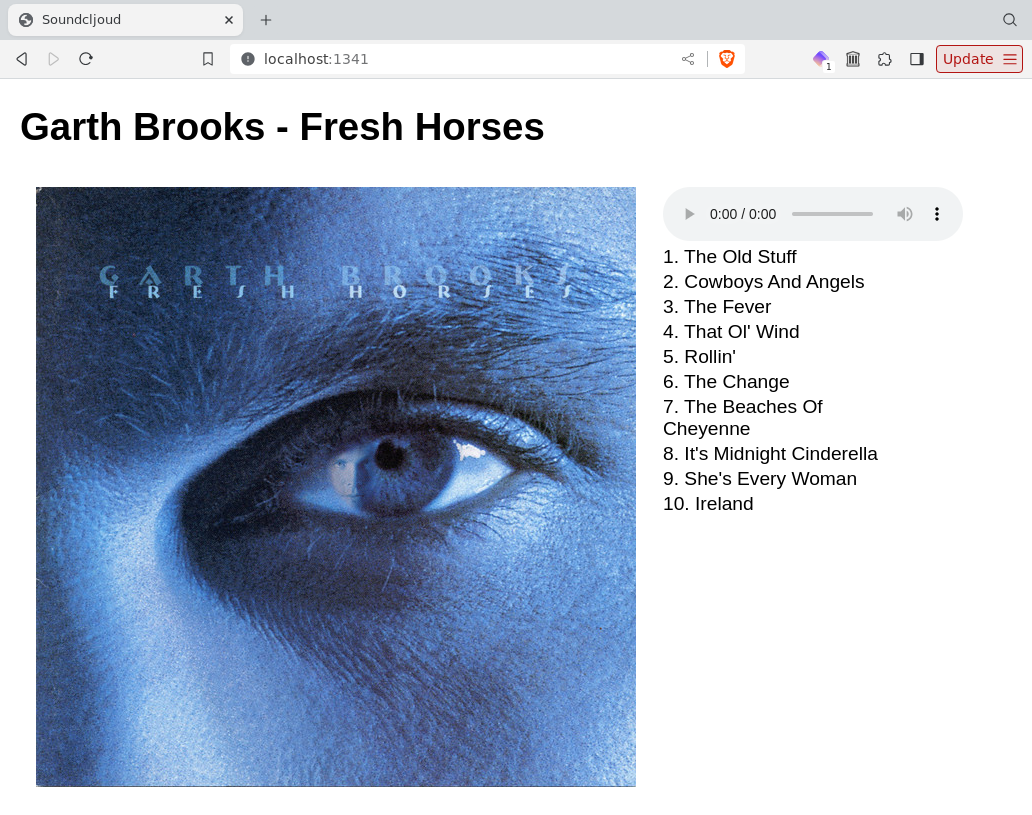
This is fantastic... if all we want to do is know what's on an album. But of course my initial problem was wanting to listen to Garth and not having a way to do that. Now I have written much Clojure and ClojureScript, and still cannot listen to Garth. 🤔
Of course what I do have is an HTML <audio> element and an MP3 file with a source URL, and I bet if I can just put these two things together, my ears will soon be filled with the sweet sweet sounds of 90s country music.
Let's start out with the simplest thing we can do, which is to activate the first track on the album once it's loaded. Since display-album! returns the album, we can just add some code to the end of the pipeline:
(comment
(def base-path "http://localhost:1341/Garth+Brooks/Fresh+Horses")
;; => #'soundcljoud/base-path
(p/->> (load-album (str base-path "/album.rss"))
display-album!
:tracks
first
:src
(set! (.-src (get-el "audio"))))
;; => #<Promise[~]>
)
As soon as we evaluate this code, the <audio> element comes to life, displaying a duration and activating the play button. Pressing the play button, we do in fact hear some Garth! 🎉
However, our UX is quite poor, since there's no visual representation of which track is playing. We can fix this by emboldening the active track:
(comment
(p/let [{:keys [number src] :as track}
(p/->> (load-album (str base-path "/album.rss"))
display-album!
:tracks
first)]
(-> (get-el "#tracks")
(.-children)
seq
(nth (dec number))
(set-styles! "font-weight: bold;"))
(set! (.-src (get-el "audio")) src))
;; => #<Promise[~]>
)
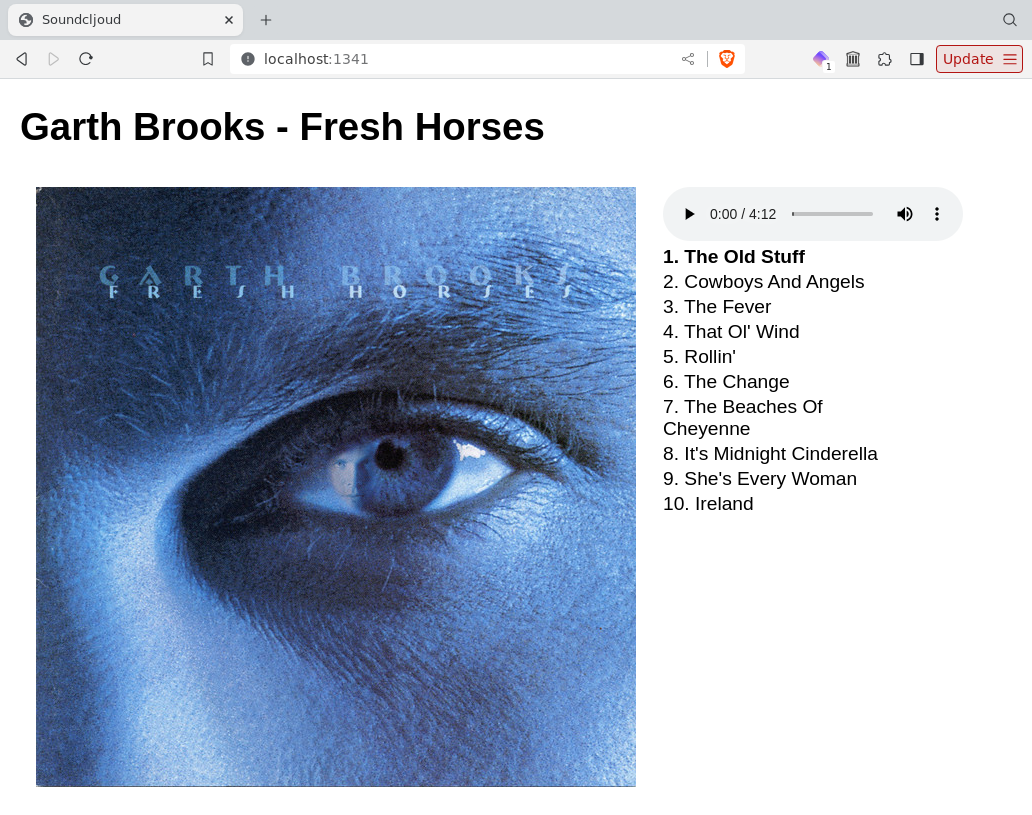
Speaking of UX, though, one would imagine that they'd be able to change to a track by clicking on it. At the moment, clicking does nothing, but that's easy enough to fix by adding an event handler to our span for each track that activates the track. Let's create a function and shovel our track activating code in there:
(defn activate-track! [{:keys [number src] :as track}]
(log "Activating track:" (clj->js track))
(let [track-spans (seq (.-children (get-el "#tracks")))]
(-> track-spans
(nth (dec number))
(set-styles! "font-weight: bold;")))
(set! (.-src (get-el "audio")) src)
track)
By the way, that clj->js function takes a ClojureScript data structure (in this case, our track map) and recursively transforms it into a JavaScript object so it can be printed nicely in the JS console.
OK, now that we have activate-track! as a function, we can use it in a click handler:
(defn track->span [{:keys [number title] :as track}]
(let [span (js/document.createElement "span")]
(set! (.-innerHTML span) (str number ". " title))
(.addEventListener span "click" (partial activate-track! track))
span))
(comment
(p/-> (load-album (str base-path "/album.rss"))
display-album!
:tracks
first
activate-track!)
;; => #<Promise[~]>
)
Evaluating this code activates the first track on the album as before, and then clicking another track highlights it in bold and loads it into the <audio> element. That's good, but what isn't so good is that the first track stays bold. 😬
Luckily, there's an easy fix for this. All we need to do is reset the weight of all the track spans before bolding the active one in activate-track!:
(defn activate-track! [{:keys [number src] :as track}]
(log "Activating track:" (clj->js track))
(let [track-spans (seq (.-children (get-el "#tracks")))]
(doseq [span track-spans]
(set-styles! span "font-weight: normal;"))
(-> track-spans
(nth (dec number))
(set-styles! "font-weight: bold;")))
(set! (.-src (get-el "audio")) src)
track)
Amazing!
Whilst we're ticking off UX issues, let's think about what should happen when our user clicks on a different track. At the moment, we load the track into the player and then the user has to click the play button to start listening to it. That is perfectly reasonable when first loading the album, but if I'm listening to a track and then select another one, I would kinda expect the new track to start playing automatically instead of me having to click play manually.
Let's see how we can do this. According to the HTMLMediaElement documentation, our <audio> element should have paused attribute telling us whether playback is happening. Let's try it out:
(comment
(p/-> (load-album (str base-path "/album.rss"))
display-album!
:tracks
first
activate-track!)
;; => #<Promise[~]>
(-> (get-el "audio")
(.-paused))
;; => true
)
Now if we click the play button and check the value of the paused attribute again:
(comment
(-> (get-el "audio")
(.-paused))
;; => false
)
Excellent! Now let's see how we programatically start playing a newly loaded track. Referring back to the documentation, we discover a HTMLMediaElement.play() method. Let's try that out:
(comment
(p/-> (load-album (str base-path "/album.rss"))
display-album!
:tracks
second
activate-track!)
;; => #<Promise[~]>
(-> (get-el "audio")
(.play))
;; => #<Promise[~]>
)
Evaluating this code results in "Cowboys and Angels" starting to play!
Now we can use what we've learned to teach activate-track! to start playing the track when appropriate:
(defn activate-track! [{:keys [number src] :as track}]
(log "Activating track:" (clj->js track))
(let [track-spans (seq (.-children (get-el "#tracks")))
audio-el (get-el "audio")
paused? (.-paused audio-el)]
(doseq [span track-spans]
(set-styles! span "font-weight: normal;"))
(-> track-spans
(nth (dec number))
(set-styles! "font-weight: bold;"))
(set! (.-src audio-el) src)
(when-not paused?
(.play audio-el)))
track)
(comment
(p/-> (load-album (str base-path "/album.rss"))
display-album!
:tracks
first
activate-track!)
;; => #<Promise[~]>
)
When the album loads, the first track is activated but doesn't start playing. Clicking on another track activates it but doesn't start playing it. However, if we click the play button and start listening to the active track, then click on another track, the new track is activated and immediately starts playing.
This, my friends, is some seriously good UX! Of course, we can improve it further.
The next UX nit that we should pick is the fact that when a track ends, our poor user has to manually click on the next track and then manually click the play button just to keep listening to the album. This seems a bit mean of us, so let's see what we can do in order to be the nice people that we know we are, deep down inside.
Our good friend HTMLMediaElement has a bunch of
events that tell us useful things about what's happening with the media, and one of these events is ended:
Fired when playback stops when end of the media (
This seems like it will fit the bill quite nicely. Hopping back in our hammock for a minute, we think about what should happen when the end of a track is reached:
We can of course add a ended event listener to the <audio> element every time a new track is activated, but this is problematic because we would then want to remove the previous event listener, and it turns out that removing event
listeners is a bit
complicated. What if we instead had an event listener that knew what track was currently playing, where that track comes in the album, and what track (if any) is next? Then we'd only have to attach a listener once, right after we load the album. Let's think through how we could do that.
So far, we've been relying on the state of the DOM to tell us things like if the track is paused. A much more functional approach would be to control the state ourselves using immutable data structures and so on. A nice side effect of this (sorry, Haskell folks, Clojurists are just fine with uncontrolled side effects) is that it actually makes REPL-driven development easier as well! 🤯
Let's start by extracting a function to handle the tedium of loading the album, displaying it, and then activating the first track:
(defn load-ui! [dir]
(p/->> (load-album (str dir "/album.rss"))
display-album!
:tracks
first
activate-track!))
Now that we have this, we'll define a top-level atom to hold the state, then update our load-ui! function to stuff the album into the atom once it's loaded:
(def state (atom nil))
(defn load-ui! [dir]
(p/->> (load-album (str dir "/album.rss"))
display-album!
(assoc {} :album)
(reset! state)
:album
:tracks
first
activate-track!))
What we're doing here is creating a map to hold the state, then assoc-ing the loaded album into the map under the :album key, then putting that map into the state atom with reset!, which returns the new value saved in the atom, which is the one we just put in there, which will look like this:
{:title "Garth Brooks - Fresh Horses",
:image "https://i.discogs.com/.../LTMxNjguanBlZw.jpeg",
:tracks
({:artist "Garth Brooks",
:title "The Old Stuff",
:number 1,
:src "http://localhost:1341/Garth+Brooks/Fresh+Horses/Garth+Brooks+-+The+Old+Stuff.mp3"}
...
{:artist "Garth Brooks",
:title "Ireland",
:number 10,
:src "http://localhost:1341/Garth+Brooks/Fresh+Horses/Garth+Brooks+-+Ireland.mp3"}), :paused? true}
We'll then grab the album back out of the map and proceed as before to activate the first track. This is a little gross, but we'll clean it up as we go.
Oh yeah, and remember when I promised this would make debugging easier? Check this out:
(comment
(load-ui! "http://localhost:1341/Garth+Brooks/Fresh+Horses")
;; => #<Promise[~]>
@state
;; => {:album {:title "Garth Brooks - Fresh Horses",
;; :image "https://i.discogs.com/.../LTMxNjguanBlZw.jpeg",
;; :tracks
;; ({:artist "Garth Brooks",
;; :title "The Old Stuff",
;; :number 1,
;; :src "http://localhost:1341/Garth+Brooks/Fresh+Horses/Garth+Brooks+-+The+Old+Stuff.mp3"}
;; ...
;; {:artist "Garth Brooks",
;; :title "Ireland",
;; :number 10,
;; :src "http://localhost:1341/Garth+Brooks/Fresh+Horses/Garth+Brooks+-+Ireland.mp3"})}}
)
That's right, we no longer have to rely on logging stuff to the JS console in our promise chains!
OK, but we haven't really changed anything other than making the load-ui! function more complicated. Let's add a little more to our state atom so we can actually tackle the problem of auto-advancing tracks. First, we'll add a :paused? key:
(defn load-ui! [dir]
(p/->> (load-album (str dir "/album.rss"))
display-album!
(assoc {:paused? true} :album)
(reset! state)
:album
:tracks
first
activate-track!))
(comment
(load-ui! "http://localhost:1341/Garth+Brooks/Fresh+Horses")
;; => #<Promise[~]>
@state
;; => {:paused? true, :album {...}}
)
Now let's add an event listener to the <audio> element that updates the state when the play button is pressed, doing a little cleanup of the load-ui! function whilst we're at it:
(defn load-ui! [dir]
(p/let [album (load-album (str dir "/album.rss"))]
(display-album! album)
(reset! state {:paused? true, :album album})
(->> album
:tracks
first
activate-track!)
(.addEventListener (get-el "audio") "play"
#(swap! state assoc :paused? false))))
(comment
(load-ui! "http://localhost:1341/Garth+Brooks/Fresh+Horses")
;; => #<Promise[~]>
(:paused? @state)
;; => true
;; Click the play button and...
(:paused? @state)
;; => false
)
If you're not familiar with swap!, it takes an atom and a function which will be called with the current value of the atom, then sets the next value of the atom to whatever the function returns, just like update does for plain old maps. And also just like update, it has a shorthand form so that instead of writing this:
(swap! state #(assoc % :paused? false))
you can write this:
(swap! state assoc :paused? false)
in which case swap! will treat the arg after the atom as a function which will be called with the current value first, then the rest of the args to swap!. You can imagine that swap! is written something like this:
(defn swap!
([atom f]
(reset! atom (f @atom)))
([atom f & args]
(reset! atom (apply f @atom args))))
It's obviously not written like that, even though that would technically probably maybe work. It's actually written like this:
(defn swap!
"Atomically swaps the value of atom to be:
(apply f current-value-of-atom args). Note that f may be called
multiple times, and thus should be free of side effects. Returns
the value that was swapped in."
{:added "1.0"
:static true}
([^clojure.lang.IAtom atom f] (.swap atom f))
([^clojure.lang.IAtom atom f x] (.swap atom f x))
([^clojure.lang.IAtom atom f x y] (.swap atom f x y))
([^clojure.lang.IAtom atom f x y & args] (.swap atom f x y args)))
But you get the point.
Aaaaaanyway, I seem to have digressed—which is firmly on brand for this blog, so I apologise for nothing!
But yeah, at this point, we're back to the functionality that we had before. If we click on a track whilst the player is paused, the new track is selected but doesn't start playing, and if we click on a new track whilst the player is playing, the player plays on by playing the new track. Got it?
However, activate-track! is still relying on the DOM to keep track of whether the player is paused. Let's fix this by checking the state atom instead:
(defn activate-track! [{:keys [number src] :as track}]
(log "Activating track:" (clj->js track))
(let [track-spans (seq (.-children (get-el "#tracks")))
audio-el (get-el "audio")
;; Instead of this 👇
;; paused? (.-paused audio-el)
;; Do this! 👇
{:keys [paused?]} @state]
;; ...
)
track)
Next, let's write a function to advance to the next track:
(defn advance-track! []
(let [{:keys [active-track album]} @state
{:keys [tracks]} album
last-track? (= active-track (count tracks))]
(when-not last-track?
(activate-track! (nth tracks active-track)))))
Oops, this is relying on :active-track being present in the state atom. Let's put it there in activate-track!
(defn activate-track! [{:keys [number src] :as track}]
(log "Activating track:" (clj->js track))
(let [track-spans (seq (.-children (get-el "#tracks")))
audio-el (get-el "audio")
{:keys [paused?]} @state]
;; ...
)
;; Swappity swap swap! 👇
(swap! state assoc :active-track number)
track)
(comment
(load-ui! "http://localhost:1341/Garth+Brooks/Fresh+Horses")
;; => #<Promise[~]>
@state
;; => {:paused? true,
;; :active-track 1,
;; :album {...}}
)
Now we should be able to actually call advance-track! to, well, advance the track:
(comment
(load-ui! "http://localhost:1341/Garth+Brooks/Fresh+Horses")
;; => #<Promise[~]>
(:active-track @state)
;; => 1
(advance-track!)
;; => {:artist "Garth Brooks", :title "Cowboys And Angels", :number 2, :src "http://localhost:1341/Garth+Brooks/Fresh+Horses/Garth+Brooks+-+Cowboys+and+Angels.mp3"}
(:active-track @state)
;; => 2
)
We will have also seen the highlighted track change when we evaluated the (advance-track!) form! 🎉
What we're building up to is of course the ability to play our album continuously. When one track ends, the next should begin. And our good friend <audio> has just what we need, in the form of the ended event. If we add one line of code to register advance-track! as the listener for the ended event:
(defn load-ui! [dir]
(p/let [album (load-album (str dir "/album.rss"))]
(display-album! album)
(reset! state {:paused? true, :album album})
(->> album
:tracks
first
activate-track!)
(.addEventListener (get-el "audio") "play"
#(swap! state assoc :paused? false))
(.addEventListener (get-el "audio") "ended"
advance-track!)))
(comment
(load-ui! "http://localhost:1341/Garth+Brooks/Fresh+Horses")
;; => #<Promise[~]>
;; Click ▶️ and witness the glory!
)
We win!
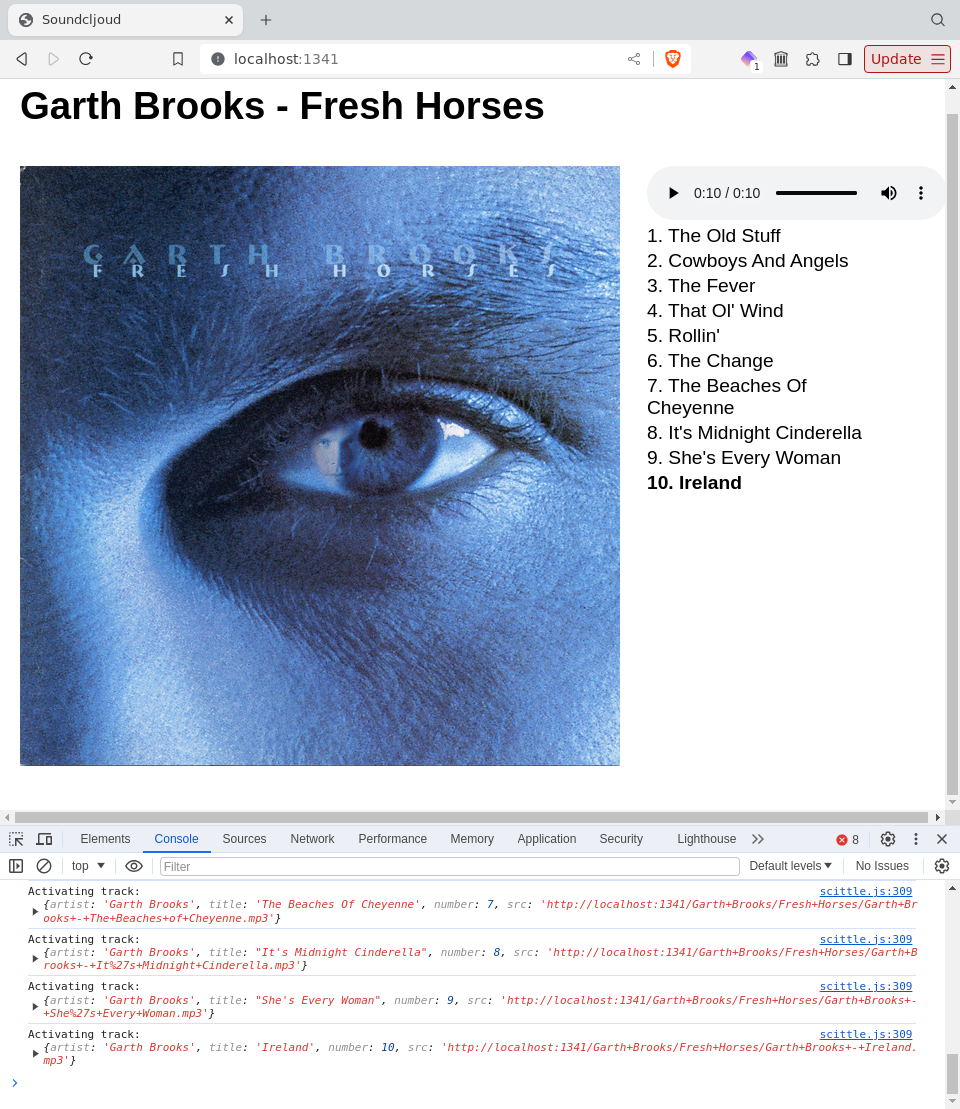
Winners who have won before and know how to win will of course know that the best thing to do after winning is to stride triumphantly to the podium, receive your 🥇, wave to your adoring public, soak up the applause like warm sunshine on a July day (unless you're in the southern hemisphere, in which case the warm sunshine is best appreciated in December, unless you're close enough to the equator to appreciate warm sunshine whenever you damn well please, unless you're too close to the equator and that sunshine is too warm to appreciate because you're sweating like wild), and then head home, find a comfy chair and open a bottle of champagne or fizzy water or tasty whiskey or whatever.
I, of course, am no such winner, so instead of retiring to my comfy chair with a glass of Lagavulin, I want to jump ahead in a track, so I confidently reach for the audio control and click ahead in the timeline, and... nothing happens WTF?
Reading more documentation, I discover that I can see the current time in seconds in the track by reading its currentTime property, and I can seek to an arbitrary time by setting currentTime, so let's give that a try, shall we? (Spoiler: we shall.)
(comment
(.-currentTime (get-el "audio"))
;; => 37.010544
(set! (.-currentTime (get-el "audio")) 50)
;; => nil
;; Why did my track start over? 🤬
(.-currentTime (get-el "audio"))
;; => 2.006649
)
To make a long story short, this all boils down to how the browser actually implements seeking. When it first loads the audio track, it issues a request like this:
GET /Garth+Brooks/Fresh+Horses/Garth+Brooks+-+The+Old+Stuff.mp3 HTTP/1.1
Range: bytes=0-
and expects a response like this:
HTTP/1.1 206 Partial Content
Accept-Ranges: bytes
Content-length: 5943424
Content-Range: bytes 0-1024000/5943424
Content-Type: audio/mpeg
It will then buffer the bytes it got back and make the track seekable within those bytes, as described here. You can peer under the hood by inspecting the buffered and seekable properties of the <audio> element:
audio.buffered.length; // returns 2
audio.buffered.start(0); // returns 0
audio.buffered.end(0); // returns 5
audio.buffered.start(1); // returns 15
audio.buffered.end(1); // returns 19
But if we do this in our player, we experience a deep feeling of melancholy:
(comment
(let [b (-> (get-el "audio")
(.-buffered))]
[(.start b 0) (.end b 0)])
;; => [0 144.758]
(-> (get-el "audio")
(.-seekable)
(.-length))
;; => 1
(let [s (-> (get-el "audio")
(.-seekable))]
[(.start s 0) (.end s 0)])
;; => [0 0]
)
The buffering looks fine, but it seems that we can only seek between 0 seconds and 0 seconds in the track, which kinda explains why attempting to set currentTime to any number that isn't 0 results in seeking back to 0. 😭
Seeking apparently only works if we get that blessed 206 Partial Content response from the webserver, so the browser knows how to make subsequent range requests to buffer more data, and unfortunately, the built-in babashka.http-server that we're using to serve up files in public/ responds like this:
HTTP/1.1 200 OK
Content-length: 5943424
Content-Type: audio/mpeg
Server: http-kit
No partial content?

We may attempt to fix this next time on "Soundcljoud, or a young man's Soundcloud clonejure", that is if there is a next time.